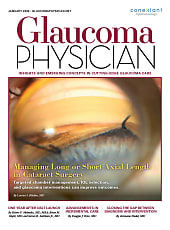I RECALL GETTING A LINKEDIN message about 5 years ago about a product that immediately piqued my interest—an adaptor for eyedrop bottles called Nanodropper. It has been known for many years that regular eyedrops are too large for the eye to fully absorb; in fact, only about 20% of the fluid is needed before systemic absorption occurs, leading to potential side effects and, depending on the medication, an inability to tolerate the drops.1-3
Patients with presbyopia, glaucoma, and other conditions of the eye requiring eyedrops, especially those with hand dexterity issues, could have a greater likelihood of missing their eye and running out of medication before treatment is complete.4 The Nanodropper has the ability to solve all of these issues and has been a critical tool that saves my practice on medication waste and administrative burden.
What Does Nanodropper Do?
The Nanodropper is an eyedrop bottle adaptor that twists onto the top of the dropper tip. It comes preassembled and sterile, making it very easy for the patient to install it on their home medications. Nanodropper then elutes a drop that is, on average, 62% smaller than a typical eyedrop.5 This triples the life of the medication bottle, creating dozens or hundreds more doses that the patient can use to get to the end of the month, if needed, or beyond.
In addition to eyedrop reduction, the Nanodropper tip makes it easier to get a drop out of the bottle. For patients who have trouble giving themselves a dose of medication, this tip provides greater margin for error. The blue tip and gray base also act as a nice bullseye target to aim the drop. The Nanodropper tip is a soft, medical-grade silicone, reducing corneal abrasion risk.

How Does It Help My Patients With Presbyopia?
The new presbyopia drop Vuity (Allergan) comes to mind. This bottle of medication costs around $80 and will last patients 2-3 times longer with a Nanodropper adaptor installed. It will last even longer for those who don’t use their drops every day. It is still important to educate your patients about the expiration dates on any medications that they may use.
What About Glaucoma Patients?
Research has shown that smaller drops can help reduce the risk of systemic and ocular side effects.6 My daily clinical practice consists heavily of glaucoma patients. Many drops that are administered on a daily basis are very effective at managing and controlling glaucoma. The issues that I, and many of you, encounter are medication tolerability and cost. With a Nanodropper installed on these drops, I have found that I can keep many of my patients on the medications I want them to be on.
Patients are extremely thankful when they know they have a medication that’s working for them, helping keep their intraocular pressure down, and stabilizing their glaucoma. It’s deflating having to take patients off these drops, whether due to tolerability issues or cost concerns. The Nanodropper adaptor has become a tool that helps me improve the care of these patients.
Can the Nanodropper Be Used in the Clinic?
Nanodropper is compatible with about 90% of multiuse bottles on the market (not preservative-free drops or single-use vials). I encourage my colleagues to consider using it on dilating drops and perioperative drops in the clinic. It makes the experience more pleasant for the patient and stretches your clinic’s eyedrop supply by 2-3 times. When there are drug shortages (as we’re all aware of these days), it can truly be a cost-effective lifeline for you and your team.
Any Information That Eye Care Professionals Should Be Aware of?
The Nanodropper team is a small but mighty group. They are very responsive and have plenty of data to back up their claims. I would encourage you to visit their website (nanodropper.com ) and navigate to their professionals page, where you’ll find compatibility data and historical data about the efficacy of smaller drops, along with literature on all the different ways Nanodropper can help you, your clinic, and your patients. ■
References
- Mishima S, Gasset A, Klyce SD Jr, Baum JL. Determination of tear volume and tear flow. Invest Ophthalmol. 1966;5(3):264-276.
- Chrai SS, Patton TF, Mehta A, Robinson JR. Lacrimal and instilled fluid dynamics in rabbit eyes. J Pharm Sci. 1973;62(7):1112-1121.
- Inoue K. Managing adverse effects of glaucoma medications. Clin Ophthalmol. 2014;8:903-913.
- Moore DB, Walton C, Moeller KL, Slabaugh MA, Mudumbai RC, Chen PP. Prevalence of self-reported early glaucoma eye drop bottle exhaustion and associated risk factors: A patient survey. BMC Ophthalmol. 2014;14:79.
- St Peter DM, Steger JS, Patnaik JL, Davis N, Kahook MY, Seibold LK. Reduction of eyedrop volume for topical ophthalmic medications with the Nanodropper bottle adaptor. Med Devices (Auckl). 2023;16:71-79.
- Song AJ, Steger JS, Robin AL. Redefining Ocular Drug Delivery. Ocul Surf. 2022;26:197-199.









